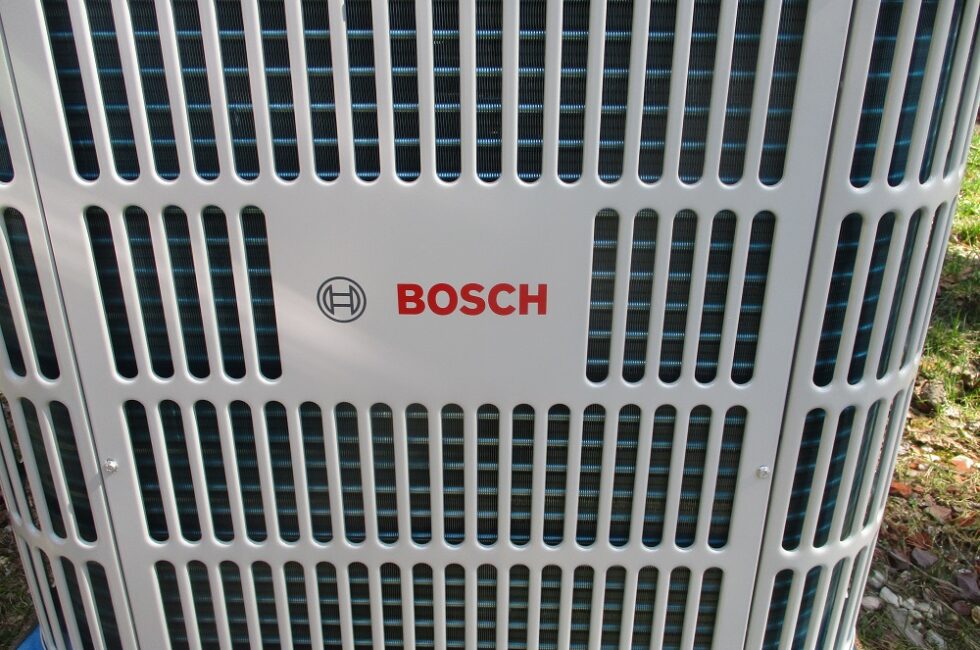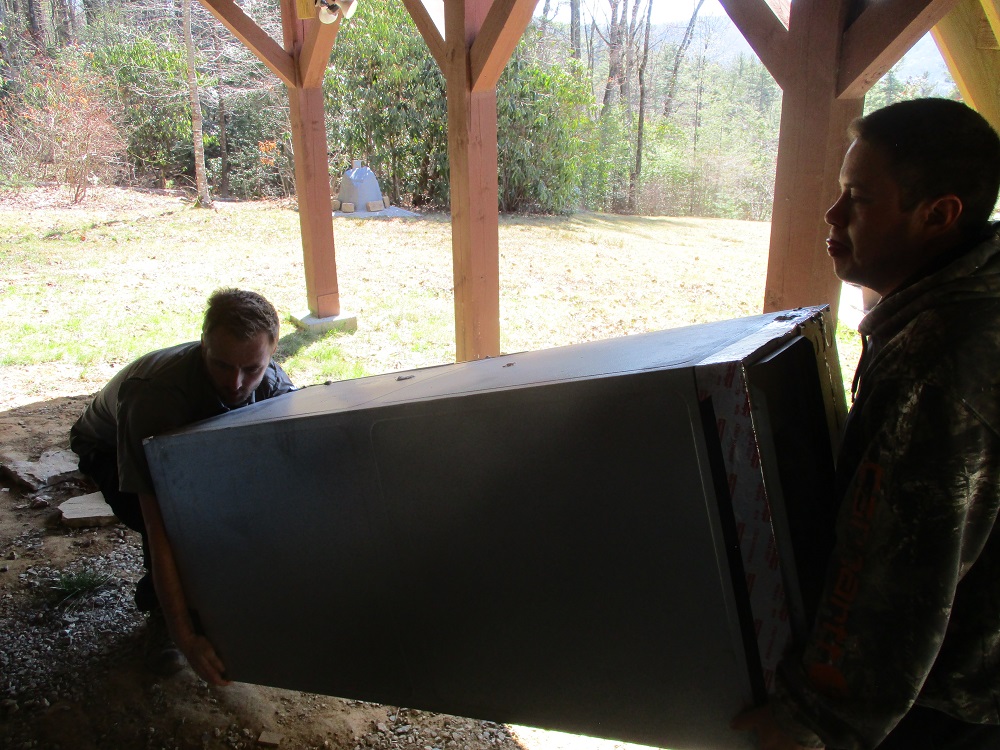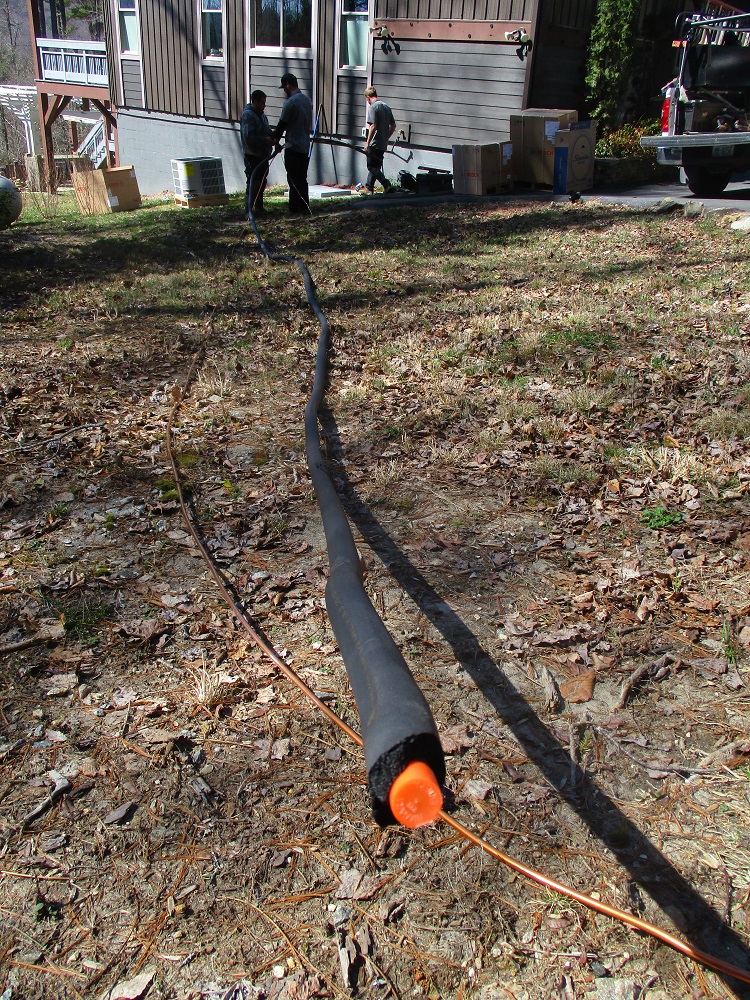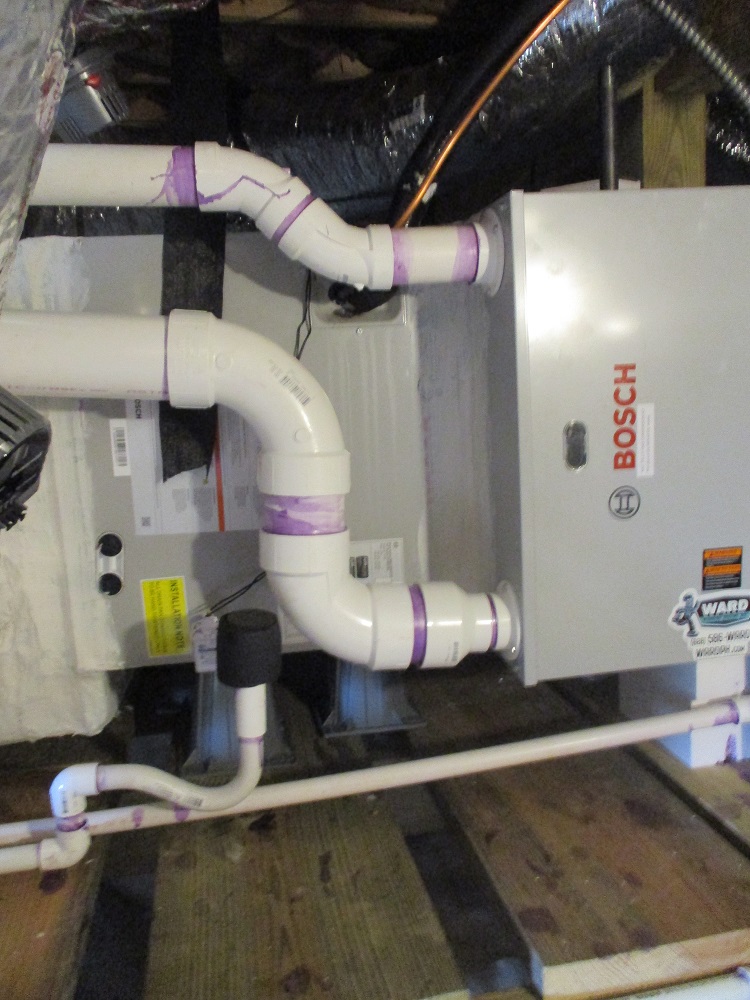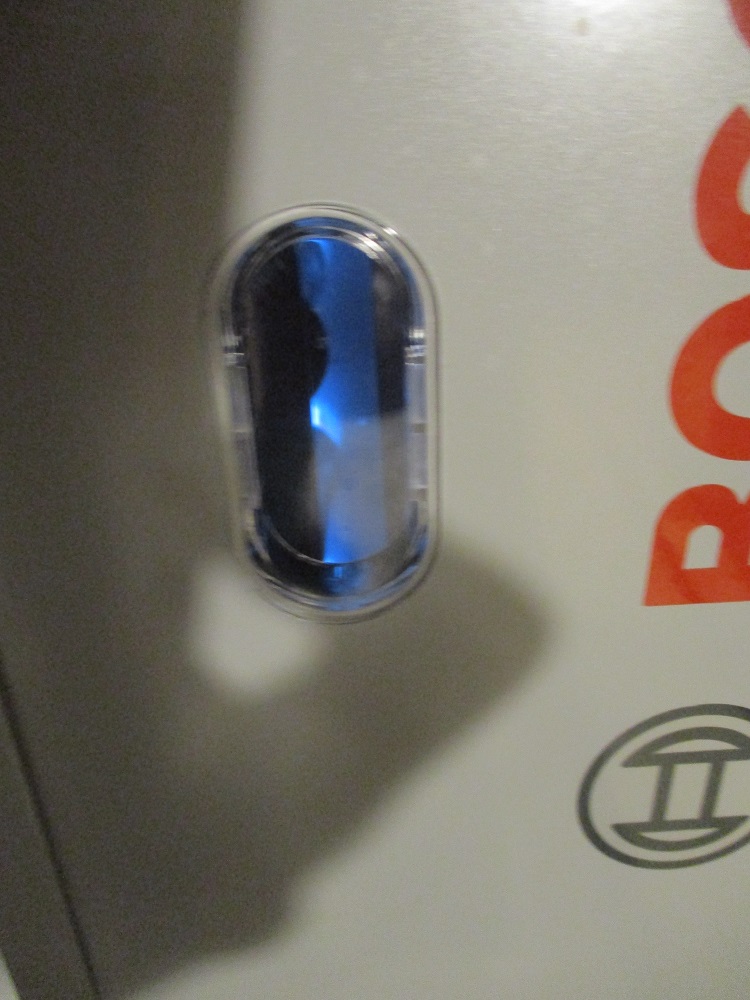Inverter Heat Pump & Dual Fuel Furnace Install is about this Architectural firm administering the change-out installation of a brand new, 2023 cutting edge technology Bosch 2.0 variable speed heat pump with LP gas furnace for the optimum energy efficiency for an existing custom mountain house.
Please see the previous online post article that led to the selection of the BOSCH IDS Premium 20 SEER inverter variable speed heat pump with gas dual fuel furnace here:
https://www.homearchitects.com/bosch-vs-trane-vs-mitsubishi-vs-lennox-vs-carrier
That previous post explains the rationale behind the choice of Bosch as opposed to Trane, Carrier, Lennox, or Mitsubishi.
With this new post, we are looking at the actual installation of the new HVAC system into an existing home that was originally built in 2018. That’s only about 4-1/2 years ago, however, the Architect-Owners wanted to greatly reduce the amount of electricity (and wattage) they used, which was also influenced by other energy saving/alternative sources such as their decisions and actions to also make these additional energy improvements, covered in these other previous online posts:
Heat Pump Hot Water Heater: https://www.homearchitects.com/heat-pump-hot-water-heater-install
240v 9.6kW Wall Charger for BMW X5 45e plug-in hybrid vehicle: https://www.homearchitects.com/bmw-home-wallbox-charger-install
All of these energy improvement conversions impact the overall energy footprint of this household.
The Wallbox Charger & new plug-in hybrid vehicle increases the amount of electricity consumed, but decreases the amount of fossil fuel (gasoline) used (resulting in 38 to 52 mpg for that plug-in SUV).
The 9,600 watts of power used by that charger is a lot of power while it is in the charging mode, which is part of why the Architect-Owners sought to reduce their electrical energy consumption in other high-power use areas, like the hot water heater and the HVAC system.
REMOVAL OF THE EXISTING HVAC SYSTEM MAIN COMPONENTS
The original house was built using Goodman 14 SEER HVAC components for both the exterior heat pump and the interior AHU (Air Handler Unit), with a 15kW heat strip as emergency auxiliary heat.
Unfortunately, the Architect-Owners discovered that evidently the production line must not have very good quality control, as evidenced by recurring problems with their Goodman heat pump. The Goodman unit worked very well, when it was working, but unfortunately had issues, such as the apparent lack of assembly line QC/QA illustrated by the fact that the heat pump was manufactured with a large copper pipe directly contacting a small copper pipe, both of which had refrigerant gas inside them under pressure, so after about 4 years, the vibration of the heat pump operation eroded a hole in the smaller copper line and embossed the larger pipe. So, the refrigerant bled out and the heat pump stopped working in the middle of winter and couldn’t produce heat. The Architect-Owners had to pay a local HVAC subcontractor over $1,300 to weld the copper holes shut and bend the smaller pipe out of the way of the larger line, then recharge with refrigerant. Steve, the local HVAC tech (who actually did a good job) showed this situation to the Architect-Owner, then dramatically illustrated bending the small pipe about an inch, so it wouldn’t be damaged again by incidental contact with the larger pipe. Now then: surely this has happened previously on these Goodman units. Why hasn’t that company done something about this in their assembly line QC/QA? Do they have any? And to add insult to injury, the Architect-Owner paid the HVAC subontractor for making the repairs, then that company refused to lift a finger to even contact Goodman-Daikin about this obvious manufacturing defect, saying “only parts” are covered by the Goodman warranty. Well hey: isn’t the heat pump itself a big “part”? This of course led the Architect-Owner to decide to never use Goodman-Daikin equipment ever again, nor that HVAC dealer-contractor. Time to change brands and subcontractors. There were also several other issues over the years with the Goodman defrost cycle, which led to a few very cold mornings in the house (which is very well insulated).
And so: here is the miserable 4-1/2 year old Goodman heat pump being removed from the house and property by the new HVAC subcontractor:
Along with the Goodman AHU:
DELIVERY AND UNBOXING OF THE NEW BOSCH SYSTEM
the new heat pump (below):
the new dual fuel gas furnace (below):
the new base for the new heat pump:
The smart new installers from the new HVAC subcontractor suggested putting the new base on top of the slightly larger old base. This keeps the new heat pump a little farther up off the ground and less likely to accumulate debris under it. Smart. The Architect-Owner ran a line of Lexel sealant along this joint, to help keep the 2 slabs from moving and the HVAC Techs also put skidproof rubber squares between them and the heat pump itself.
Changing out the natural gas burners for the LP gas burners (below):
the new stainless steel heat exchanger tubes in the new furnace (below):
20 year warranty on this high-end heat exchanger (above).
Installed new Bosch heat pump (below):
Note: the old Goodman heat pump was never installed level; it had a slight tilt. Interesting that this new HVAC subcontractor took pains to make this new high-end unit level.
Below: HVAC Tech installs a surge protector (below) (not provided on the previous old heat pump (which may have been part of the reason for bad defroster card and other issues). Nice that this new HVAC subcontractor does things first rate to protect the micro-circuitry in their installed heat pumps (and the investment made by their customers).
LINE SET BOXED ON TRUCK
HVAC WORK TRUCK WITH THOUSANDS OF COMPONENTS
Shameless plug for new HVAC subcontractor:
Lineset (connector copper piping, low voltage thermostat wiring, insulation) (below):
ELECTRICIAN IN CRAWLSPACE running new thicker wire and larger amp breaker for the new heat pump
VACATED SPACE FOR THE NEW AHU/FURNACE
SETTING THE NEW AHU/DUAL FUEL FURNACE
The very smart and capable HVAC Technicians had to move the wiring harnesses from one side of the furnace to the other, to make it accessible in the necessary orientation. For anyone saying “I’m going to build my own house” look carefully at these photos and think about whether you have the required knowledge, experience, training and abilities to do this. It is extremely complicated. One mistake and the entire apparatus won’t work. Everything has to be done correctly.
VENTING THE NEW FURNACE TO THE OUTSIDE
The top piping (special type of PVC) exhausts to the outside world. The bottom PVC pipe is the fresh combustion air intake from the outside. The clever installers made sure they used outside fittings with sturdy metal grate inserts that prohibit birds and rodents from gaining access into the crawlspace through them.
Also note the proper insulated condensate drain line T under the new furnace, so that these pipes can have bleach or compressed air inserted twice a year to inhibit mold growth in these pipes.
INSTALLATION OF SURGE PROTECTORS
Outstanding installation company installed a surge protector at the panel, protecting both the new HVAC furnace and the expensive heat pump HWH they installed the previous week:
Any equipment with micro-circuitry should have a surge protector of size and capability to protect that equipment.
This is a first-class installation, accomplished to have the components last for decades. Rather than some other companies that want the equipment to fail so that they can bill the homeowner for repairs.
GAS LINE INSTALLATION
The new furnace uses LP Gas for its fuel, the 250 G tank which the owner has outside, near to the crawlspace, and there are 3/4″ iron pipes carrying this gas into the crawlspace, available. So the gas company installed a T into the existing gas line about 7 feet away from the new furnace.
And here is the new gas line connecting to the top stub-up above the new furnace:
Here is the first blue gas flame ignition in the new furnace.
And this is the HVAC Tech adjusting the gas pressure water columns for Stage 1 and Stage 2 heat/fan levels:
And the completed furnace installation:
Looks kind of like a complex jet engine, doesn’t it?
NEW THERMOSTAT
The old-fashioned Honeywell low-end thermostat was removed and this new high-tech programmable wi-fi Trane XL824 unit installed upstairs and downstairs:
The programming is complex. Fortunately this outstanding HVAC subcontractor has skilled HVAC Techs that know how to do this swiftly and surely. This unit provides a heating high and low setpoints and cooling high and low setpoints. It also allows you to choose an AUTO mode that will automatically switch between heating and cooling based on your setpoints. It also has lockouts that allow the service tech to set the heat pump to stop operation at let’s say 25*F, and call the dual fuel furnace into action below that external temperature. In other words, the very economical variable speed inverter heat pump will work to cool and heat all the way down to 25*, then the gas furnace will take charge, but only below 25*F. This results in not very much gas consumed. And excellent interior comfort levels. Also: since this thermostat is wi-fi, it is also connected to Nexia/Trane apps on the Owner’s phones so they can see what is happening away from home and even change the temperature setpoints from hundreds of miles away.
ONE LAST IMPORTANT ITEM
The new HVAC subcontractor the Architect-Owner engaged to perform this work is the ONLY regional area HVAC provider that offers a 10 year LABOR extended warranty. For $649 (one time payment for the entire length of time that Bosch guarantees their equipment). Before anyone makes light of this, think about what the HVAC sub is offering: a 10 year labor warranty. They are the only company in western NC to offer this. So they will appear when there’s a problem and fix it for free. Their labor will have no charge. There will still be a charge for consumables like refrigerant and other items perhaps not covered by the manufacturer’s warranty. But those items are minor compared to the labor charge by other local HVAC companies. LOOK FOR AN HVAC COMPANY IN YOUR AREA THAT OFFERS A SIMILAR EXTENDED LABOR WARRANTY LIKE THIS. IT IS WORTH IT. You will save thousands of $ and provide yourself with a worry-free decade of both parts and labor. Amazing. Only the best HVAC companies offer this. Because: they do such good work, they know they will rarely have to fix anything. And the equipment they provide is among the best in the world.

